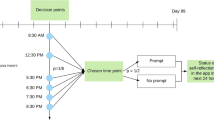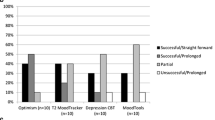Abstract
Military operational requirements potentially limit access to behavioral health care for service members. Although mobile technology solutions are increasingly viable, a secure method for mobile data exchange between patients and providers has yet to be adopted in military health care. Usability testing is the industry standard prior to implementing new technology. This paper demonstrates usability testing on a secure data exchange system between mCare and T2 Mood Tracker. Sixteen civilian providers in an outpatient behavioral health clinic tested the mCare Provider Portal, and nine uniformed proxy patients tested the Mood Tracker app. The System Usability Scale (SUS) was used as an outcome measure, which is composed of usability and learnability sub-factors. Proxy patients rated the mobile app as acceptable on the SUS, with average usability and above average learnability. Providers had less favorable views of the mCare Provider Portal, which they rated as marginal across all domains. Participants expressed enthusiasm about the potential of the provider web portal/patient smartphone app system, but had concerns about technical difficulties and ethical issues when exchanging data electronically. The results suggest a willingness to use technology to share data between patients and providers, but also a need for refinement of system usability before full-scale implementation.




Similar content being viewed by others
References
Armstrong, C. M., Hoyt, T., Kinn, J. T., Ciulla, R. P., & Bush, N. E. (2017). Mobile behavioral health applications for the military community: evaluating the emerging evidence base. Best Practices in Mental Health, 13, 106–119.
Bangor, A., Kortum, P., & Miller, J. (2009). Determining what individual SUS scores mean: adding an adjective rating scale. Journal of Usability Studies, 4, 114–123.
Brooke, J. (1996). SUS: a “quick and dirty” usability scale. In P. W. Jordan, B. Thomas, B. A. Weerdmeester, & A. L. McClelland (Eds.), Usability evaluation in industry (pp. 189–194). London: Taylor and Francis.
Bush, N. E., Ouellette, G., & Kinn, J. (2014). Utility of the T2 Mood tracker mobile application among army warrior transition unit service members. Military Medicine, 179, 1453–1457.
Dale, O., & Hagen, K. (2007). Despite technical problems personal digital assistants outperform pen and paper when collecting patient diary data. Journal of Clinical Epidemiology, 60, 8–17.
Department of Defense (2014) Department of Defense Directive 8100.2, Use of commercial wireless devices, services, and technologies in the Department of Defense (DoD) Global Information Grid (GIG). Washington, DC: Author.
Dolan, C., Adler, A., Thomas, J., & Castro, C. (2005). Operations tempo and soldier health: the moderating effect of wellness behavior. Military Psychology, 17, 157–174.
Dumas, J., & Redish, J. (1999). A practical guide to usability testing. Portland: Intellect Books.
Faulkner, L. (2003). Beyond the five-user assumption: benefits of increased sample sizes in usability testing. Behavior Research Methods, Instruments, & Computers, 35, 379–383.
Fiordelli, M., Diviani, N., & Schulz, P. J. (2013). Mapping mHealth research: a decade of evolution. Journal of Medical Internet Research, 15, e95.
Giota, K., & Kleftaras, G. (2014). Mental health apps: innovations, risks, and ethical considerations. E-Health Telecommunication Systems and Networks, 3(3), 19–23.
Hoeft, T. J., Fortney, J. C., Patel, V., & Unützer, J. (2018). Task-sharing approaches to improve mental health care in rural and other low-resource settings: a systematic review. J Rural Health, 34, 38–62.
Hoyt, T., Garnica, G., Marsh, D., Clark, K., Desadier, J., & Brodniak, S. (2015). Behavioral health trends throughout a 9-month brigade combat team deployment to Afghanistan. Psychological Services, 12, 59–65.
International Organization for Standardization (1998) ISO 9241-11, Ergonomics of human-system interaction – Part 11: Usability: definitions and concepts. Geneva, Switzerland: Author.
Kensing, F., & Blomberg, J. (1998). Participatory design: issues and concerns. Computer Supported Cooperative Work, 7, 167–185.
Krueger, R., & Casey, M. (2015). (Fifth edition) Focus groups: a practical guide for applied research. Thousand Oaks: Sage.
Krug, S. (2010). Rocket surgery made easy: the do-it-yourself guide to finding and fixing usability problems. Berkeley: New Riders.
Lewis J, Sauro J (2009) The factor structure of the system usability scale. In International conference on human centered design (pp. 94-103). Springer, Berlin, Heidelberg.
National Defense Authorization Act for Fiscal Year 2017 (2016) Pub. L. No. 114-328, § 130 Stat. 2000
Poropatich, R., Pavliscsak, H., Tong, J., Little, J., & McVeigh, F. (2014). mCare: using secure mobile technology to support soldier reintegration and rehabilitation. Telemedicine and e-Health, 20, 563–569.
Prensky M (2001) Digital natives, digital immigrants. On the Horizon 9(5), 1–6.
Virzi, R. (1992). Refining the test phase of usability evaluation: how many subjects is enough? Human Factors, 34, 457–468.
Zapata, B., Fernández-Alemán, J., Idri, A., & Toval, A. (2015). Empirical studies on usability of mHealth apps: a systematic literature review. Journal of Medical Systems, 39(2), 1–19.
Zur O, Zur A (2016) On digital immigrants and digital natives: how the digital divide affects families, educational institutions, and the workplace. Retrieved from http://www.zurinstitute.com/
Funding
Dr. Kinn and Dr. Bush reports grants from Telemedicine and Advanced Technology Research Center (TATRC) during the conduct of the study. This study was funded by the AMEDD Advanced Technology Initiative (AAMTI), through the Telemedicine and Advanced Technology Research Center (TATRC).
Author information
Authors and Affiliations
Corresponding author
Ethics declarations
Conflict of Interest
The authors declare that they have no conflict of interest.
Additional information
Publisher’s Note
Springer Nature remains neutral with regard to jurisdictional claims in published maps and institutional affiliations.
This study was conducted under an exemption from the Institutional Review Board at Madigan Army Medical Center.
The opinions or assertions contained herein are the private views of the authors and are not to be construed as official or reflecting the views of the U.S. Government, the Department of Defense, the Department of the Army, or the Defense Health Agency.
Rights and permissions
About this article
Cite this article
McCreight, S.J., Brinton, C., Kinn, J. et al. Integration of mCare and T2 Mood Tracker: Illustrating mHealth Usability Testing. J. technol. behav. sci. 4, 130–138 (2019). https://doi.org/10.1007/s41347-019-00087-w
Published:
Issue Date:
DOI: https://doi.org/10.1007/s41347-019-00087-w




